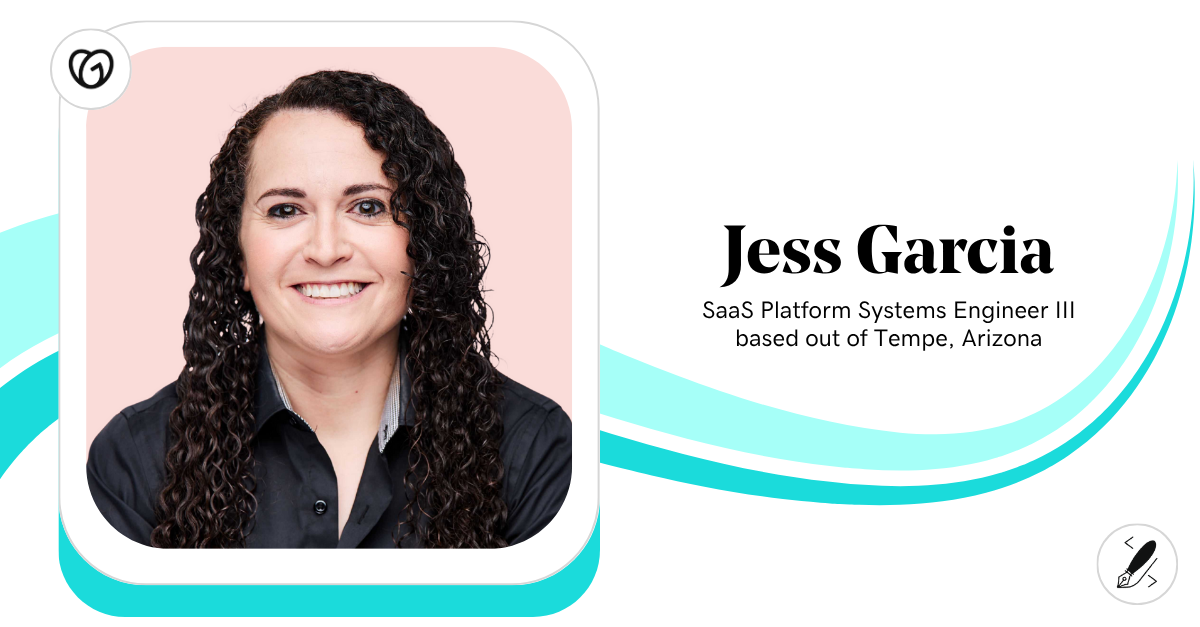This post was originally published on June 24, 2019, and was updated on June 7, 2021.
When it comes to setting up and managing an eCommerce business, learning how to write product descriptions may seem like a relatively simple task. On the flip side, if you sell multiple products, it can feel monotonous and repetitive. However, product descriptions shouldn’t be glossed over or written in a hurry. They’re a small but mighty tool that can work wonders for customer interest and sales.
An effective product description has the power to convert a browser into a customer.
Research shows that 87% of shoppers say that detailed product content is important to their overall purchase decision. Moreover, eCommerce sales are at an all-time high with consumers spending $861.12 billion online with U.S. retailers in 2020, a 44% increase from the previous year. You can’t afford to miss a piece of that pie with lackluster product descriptions.
A successful product description requires the right balance of storytelling, rich content and SEO awareness. Use the following guide (with real-life examples) to learn how to write product descriptions that will boost your sales.
Related: How to create a compelling eCommerce product page
Learn how to write product descriptions that tell a story
As you write product descriptions, try to describe an experience, not just the product itself.
Focus on making the reader envision themselves using (and enjoying) your product.
If appropriate, go as far as describing a time or place.
For example, look at the description for the below Bumble and bumble hair product. There’s a tagline under the product name “Sweat fearlessly. Clean Instantly.” Immediately, you already understand what this product does. Then the description further explains how you feel post-workout with sweaty hair, and how it can combat that issue. The benefit icons are just the cherry on top! (More on benefits later…)
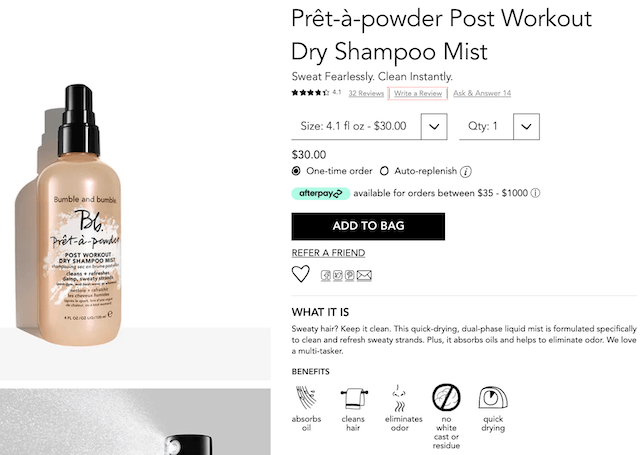
Product descriptions that tell a story are persuasive to potential customers, nudging them towards the “add to cart” button. The story doesn’t have to be all flowery language — it can also include informative details. In fact, consumers are 131% more likely to buy from a brand after they consume educational content .
Apple is the masterclass example of marrying storytelling with information within their product descriptions. Cameron Craig, who worked in PR for Apple, told the Harvard Business Review:
“Our mission was to tell the story of how our innovative products give customers the power to unleash their creativity and change the world.”
You can see just that in the product description of the latest MacBook Air. The copy immediately educates the reader on how this product will optimize their personal and professional lives. They also break down complex technological specs (like CPUs) and explain what that means for users in practice, i.e., you can complete more tasks and waste less battery.
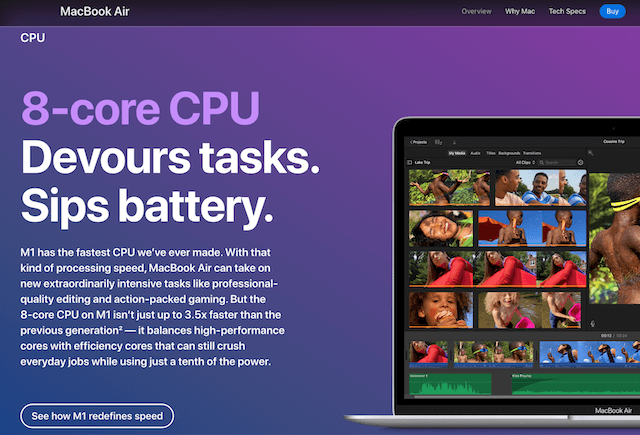
Write product descriptions that highlight your unique value proposition
What makes your product different from the rest? Your unique value proposition (UVP) is your product’s differentiator, it’s what makes it noteworthy, and also worth buying. You should include your UVP near the beginning of your product description to quickly convince customers.
If you aren’t sure what that might be, do a little competitor research to see what other brands say about similar products and figure out why yours is different.
For example, refer to GoPro’s description of their latest Hero9 camera. They highlight that the device takes 5K video and has 7x more resolution than typical HD content.
Not only do they speak about their best selling points but they also explain why this version is better than the previous iterations. The copy describes the benefits of Hypersmooth 3.0, the latest update to their stabilization technology.
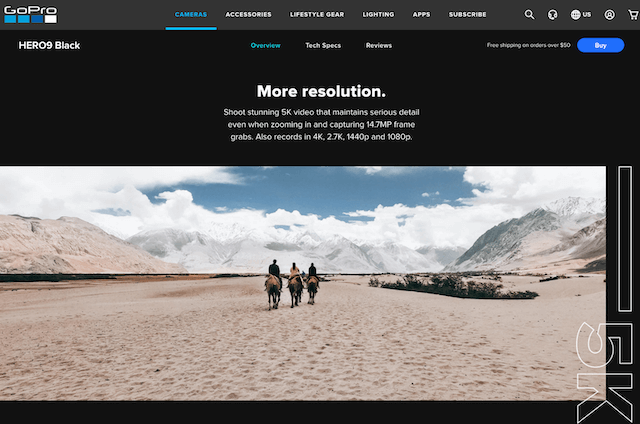
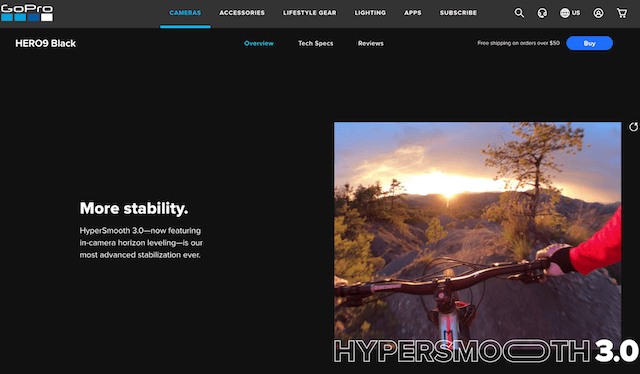
Related: How to write and use a unique selling proposition
Master product descriptions that consider your target customer
As you explore how to write product descriptions, think not only about your target customer, but also how they will use the product.
Focus on the benefits for the customer, not just the features of the product.
While features are important and have their place (more on that later), benefits create compelling copy that convinces the customer why they need the product.
When thinking about the product and customer, ask yourself:
- How will it make their life easier?
- What problem will it solve?
- What advantages will it provide?
Those are the types of benefits you should highlight first and foremost in your product description.
Read the first two paragraphs in Goop’s description for a skincare product. It immediately dives into what the product will do for the customer’s skin, describing, in detail, all the results users can expect.
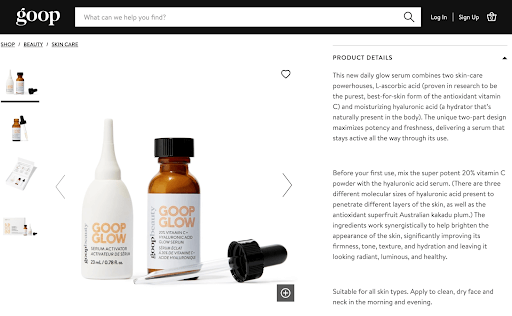
Use product descriptions that match your tone to your buyer persona
When you write a product description, you also want to consider your target customer so that you can speak directly to their buyer persona.
One way to accomplish this is by matching the tone of the product description to your ideal customer.
For instance, if your audience is millennial consumers and you’re selling a lifestyle product, you can inject humor and frivolity to catch their attention.
On the other hand, if you sell professional-level tech products targeted toward business buyers, you’ll want to keep the tone more serious and detailed.
The perfect example of tone is Dollar Shave Club, a brand that made a name for itself with irreverent humor. Notice how their product description reflects its overall brand voice (and matches the tone of their audience) with tongue-in-cheek jokes.
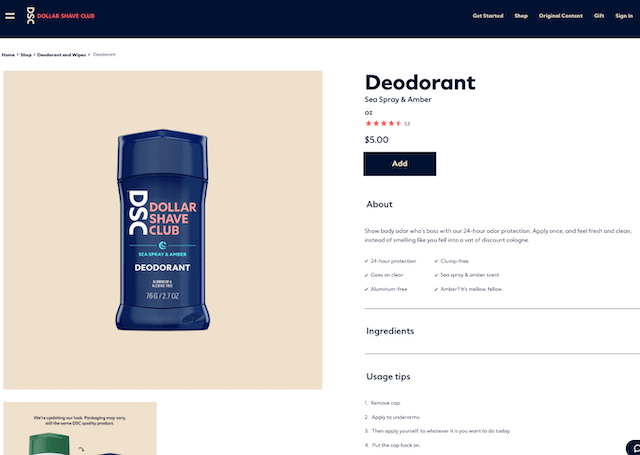
Make your product descriptions concise and scannable
The above-the-fold section of your product page should contain the best copy. Remember that every word matters. Potential customers can scroll or click for more information if they’d like. That means your initial product description should be concise and to the point.
Whether you offer an expandable description or tabs below the fold with more features and details, the idea is to make the first product description scannable to hook the customer.
Scannability is also crucial for mobile customers so that they can see product descriptions easily on their phones.
Make sure to keep mobile-friendliness in mind as 79% of smartphone users made a purchase on their mobile device in the past six months.
Many brands use bullet points to help with scannability in their product descriptions. Notice how Home Depot includes bullet points in both its initial product description, as well as the expanded product overview.
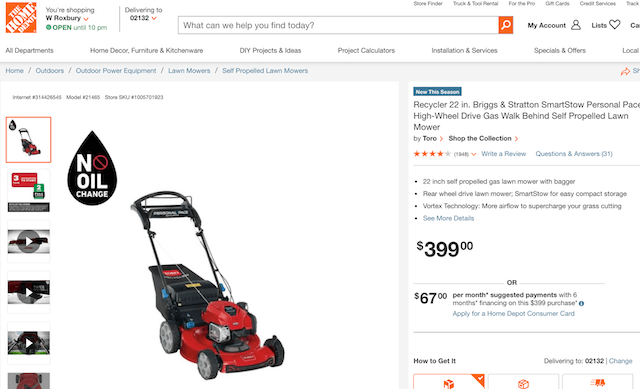
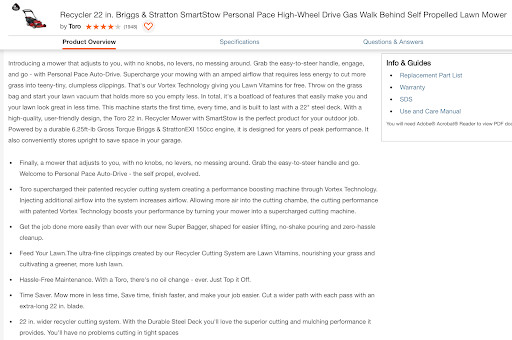
Include multiple high-quality images with product descriptions
Holding a product is vital to certain consumers. Even with the eCommerce boom from the pandemic, a recent survey found that 46% of people still prefer to shop in stores. And 33% say it's because they want to see, touch, feel and try out items.
Ecommerce brands can overcome this hurdle by including stellar product images from multiple angles.
You don’t necessarily need to hire a professional photographer to take product pictures (although if you have the budget, it can be worth it). High-res camera phones with portrait mode make it increasingly easier for eCommerce business owners to DIY product images.
When possible include images of the product in use, like someone wearing a piece of clothing, a customer using a tool — or even a screenshot of a digital product. These types of images help contextualize the product in action, which makes it seem more real and tangible.
Note how Thrive Market overcomes the issue of selling spices (becasue it’s essentially just a ground-up powder, it’s tough to really spotlight in an exciting way). But they still use pictures to their advantage, showing the packaging, so customers know what to expect. They also incorporate an image of a meal that uses the spice, helping to put the product into context.
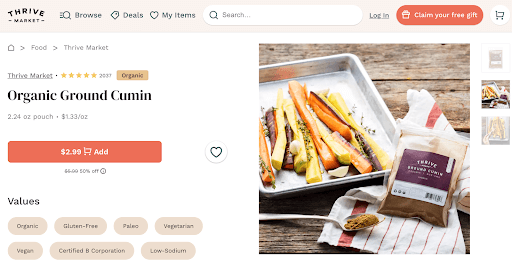
Related: How to take product photos that will help sell your goods
Incorporate customer testimonials with product descriptions
User-generated content (UGC) is a powerful tool in driving sales for your eCommerce business.
Customer testimonials and reviews are the best types of UGC to include in product descriptions.
Reviews help to provide social proof that other satisfied customers purchased and used your product, which goes a long way to encourage potential buyers.
Recent research confirms that UGC influences the consumer purchase decision process.
Depending on the layout and format of your eCommerce site, you can include a link to the product review page, or have native reviews underneath the product description.
Some brands opt to cherry-pick positive reviews or testimonials and include it as a quote in their product description.
Related: Generate reviews -- 8 ways to get more product reviews
Make product descriptions searchable with SEO
If you want more customers to find your product with organic search (via search engines such as Google or Bing), write product descriptions with SEO in mind.
Each individual product page on an eCommerce site is another opportunity to include high-quality content that’s indexed by search engines.
When product descriptions are optimized for search engines, those indexed pages will ideally rank for your target keywords. In other words, a potential customer types in a query related to your product/brand, and your site appears as a top result in the Search Engine Results Page (SERP).
If you haven’t already, do some basic keyword research, so you know what terms and phrases to include in your product description. Keywords are terms that directly relate to your product that a potential customer might type into a search engine when looking to find it.
Make a list of keywords and naturally include them in product descriptions, details and anywhere on your product page.
Don’t forget about long-tail keywords— these represent longer phrase/question searches rather than specific two- to five-word keywords. To give you an idea, instead of the keyword “cleaning supplies,” a long-tail keyword would be “affordable organic cleaning spray solution.”
Google tells us more and more consumers use conversational search queries. Searches with “do I need” grew in popularity by 65% — these are searches like: “what size generator do I need?”
Their advice on using this to your advantage? “Lock down keywords and phrases typically associated with [your] businesses and then consider natural language search phrases that customers might be using to find them.”
Make product descriptions that include useful and technical details
After you craft and hone your initial product description, include technical and specific product details. As you’ve seen in the examples above, the product details section typically comes below the fold and under the initial product description.
However, that doesn’t mean it’s not as important.
Consumers have specific needs and concerns when it comes to purchasing a product, and details can be a make or break when it comes to conversion. Just think: what if someone has a skin allergy and can’t find the materials for a clothing item?
Your goal with product details should be to answer any question before a customer asks it, and provide useful information to help them on their buying journey.
A good example is Macy’s — they include the height and clothing size of the models in their product pictures. These details give the buyer additional insight into how items fit on an actual person, for example where a dress hem might fall.
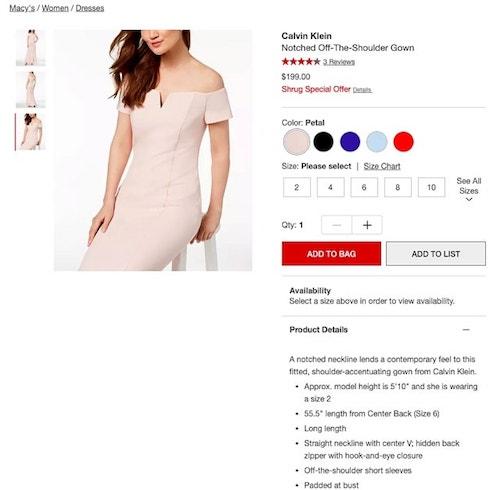
A/B test your product descriptions
Once you nail down how to write product descriptions, don’t stop there. A/B test descriptions against one another to try out different tactics and find the best options. You can formally A/B test with marketing tools such as Google Optimize, Optimizely or Visual Website Optimizer.
Alternatively, you can do informal A/B testing by using different versions or formats for descriptions on similar products to see which sells better over a certain period of time.
Every eCommerce business is different, and there’s no-one-size-fits-all formula when it comes to product descriptions.
Testing your product pages will allow you to improve your descriptions to increase traffic and sales.
Make sure to check in with all product pages, if one seems to be selling better than the rest, try to repurpose that description on the low-selling products. Remember that data and metrics will help you refine your process.
Editor’s note: With dedicated product pages, GoDaddy Online Store makes it easy to update your product descriptions.
Learn how to write product descriptions to drive more sales
Product descriptions have the power to increase sales for your eCommerce business dramatically, yet large and small companies alike can struggle with them. Whether you have 10 or 10,000 products, it can be challenging to write unique, customer-attracting descriptions. But trust us, when you put in the effort, using the above tips, you’ll see the ROI!
The main takeaway? Don’t get disheartened when setting up your eCommerce store. Follow this guide, and with a little creativity, strategy, and persistence, your product descriptions will increase conversions for your online store.
This article includes content originally published on the GoDaddy blog by Erik Deckers.






